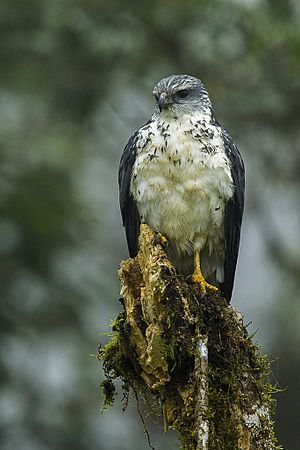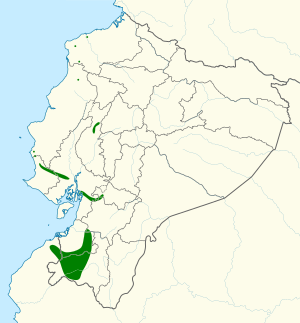Grey-backed hawk facts for kids
Quick facts for kids Grey-backed hawk |
|
|---|---|
 |
|
| Conservation status | |
| Scientific classification | |
| Genus: |
Pseudastur
|
| Species: |
occidentalis
|
 |
|
| Synonyms | |
|
Leucopternis occidentalis |
|
The grey-backed hawk (Pseudastur occidentalis) is a special type of bird of prey that lives in Ecuador and the very northern part of Peru. It belongs to the group of "true" hawks and is currently listed as an Endangered animal. This means there are not many of them left in the wild, and they need our help to survive.
Contents
About the Grey-Backed Hawk
What is Taxonomy?
Taxonomy is the science of naming, describing, and classifying living things. It helps scientists organize all the different plants and animals on Earth. The grey-backed hawk used to be in a group called Leucopternis. However, after some new research in 2006, scientists decided to move it and two other hawk species to a new group called Pseudastur. The grey-backed hawk is also monotypic, which means it is the only species in its specific group that doesn't have any subspecies.
What Does it Look Like?
The grey-backed hawk is about 45 to 52 centimeters (18 to 20 inches) long. Its wings can spread out to about 104 to 116 centimeters (41 to 46 inches) wide. Female hawks are a bit bigger than males, but both sexes look very similar.
Adult grey-backed hawks have a head, neck, and back that are streaked with gray and white. Their upper parts are a dark, blackish-gray. Their tail is mostly white with a wide black band near the end. They have dark brown eyes, a gray cere (the waxy part above their beak), and pale yellow legs and feet. Young hawks have brownish-gray upper parts, a streaky neck, and gray spots on their chest.
Where the Grey-Backed Hawk Lives
Habitat and Range
You can find the grey-backed hawk in certain areas of western Ecuador, from the southern Esmeraldas area down to Loja. It also lives a little bit into Peru's Department of Tumbes.
These hawks like to live in different kinds of forests, such as:
- Subtropical and tropical forests that lose some leaves in dry seasons.
- Evergreen forests that stay green all year.
- Cloudforests, which are forests often covered in clouds.
- Secondary forests, which are forests that have grown back after being cut down.
They prefer places that are moist and are often seen in steep, narrow valleys called ravines. They usually live at elevations between 100 and 1,400 meters (330 and 4,600 feet) above sea level, but they can sometimes be found as high as 2,900 meters (9,500 feet).
How the Grey-Backed Hawk Behaves
Movement
The grey-backed hawk is a sedentary bird. This means it does not migrate or travel long distances. It stays in the same area all year round.
Feeding Habits
Scientists don't know a lot about exactly how the grey-backed hawk hunts or what its main diet is. However, they have been seen hunting over streams and in farm fields. Sometimes, up to four of these hawks will hunt together. Their diet includes:
- Reptiles
- Amphibians
- Crabs
- Rodents
- Smaller birds
- Large insects
Reproduction and Life Cycle
It seems that grey-backed hawks can nest at any time of the year. However, they are most active in breeding between December and April, which is the rainy season in their habitat. During this time, pairs of hawks will perform special display flights in the air. Not much else is known about how they raise their young or their full breeding cycle.
Vocalization
When grey-backed hawks perform their display flights, one bird will make a long, screeching sound. It sounds like "keeeaaarr-keeeaaarr..." and gets louder in the middle. Sometimes, they make a different high-pitched sound, like "kéééoooowww".
Status and Conservation
Why is it Endangered?
The IUCN (International Union for Conservation of Nature) first listed the grey-backed hawk as "Threatened." But since 1994, they have changed its status to "Endangered." This is because the hawk lives in a small area, and its population is shrinking. Scientists believe there are only about 250 to 1,000 adult grey-backed hawks left.
The main reason their numbers are going down is because their forest homes are being destroyed. People are cutting down trees for wood and clearing land for farming. Even in areas that are supposed to be protected, trees are sometimes illegally cut down. The forests in western Ecuador, where these hawks live, are considered one of the most threatened ecosystems in the world. This is due to a combination of clearing land for farms, getting wood, and intense grazing by goats and cattle, which damages the forest floor.
See also
 In Spanish: Busardo dorsigrís para niños
In Spanish: Busardo dorsigrís para niños


